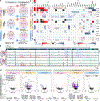High level of novelty under the hood of convergent evolution
- PMID: 36893249
- PMCID: PMC11000492
- DOI: 10.1126/science.ade0004
High level of novelty under the hood of convergent evolution
Abstract
Little is known about the extent to which species use homologous regulatory architectures to achieve phenotypic convergence. By characterizing chromatin accessibility and gene expression in developing wing tissues, we compared the regulatory architecture of convergence between a pair of mimetic butterfly species. Although a handful of color pattern genes are known to be involved in their convergence, our data suggest that different mutational paths underlie the integration of these genes into wing pattern development. This is supported by a large fraction of accessible chromatin being exclusive to each species, including the de novo lineage-specific evolution of a modular optix enhancer. These findings may be explained by a high level of developmental drift and evolutionary contingency that occurs during the independent evolution of mimicry.
Figures




References
MeSH terms
Grants and funding
LinkOut - more resources
Full Text Sources

